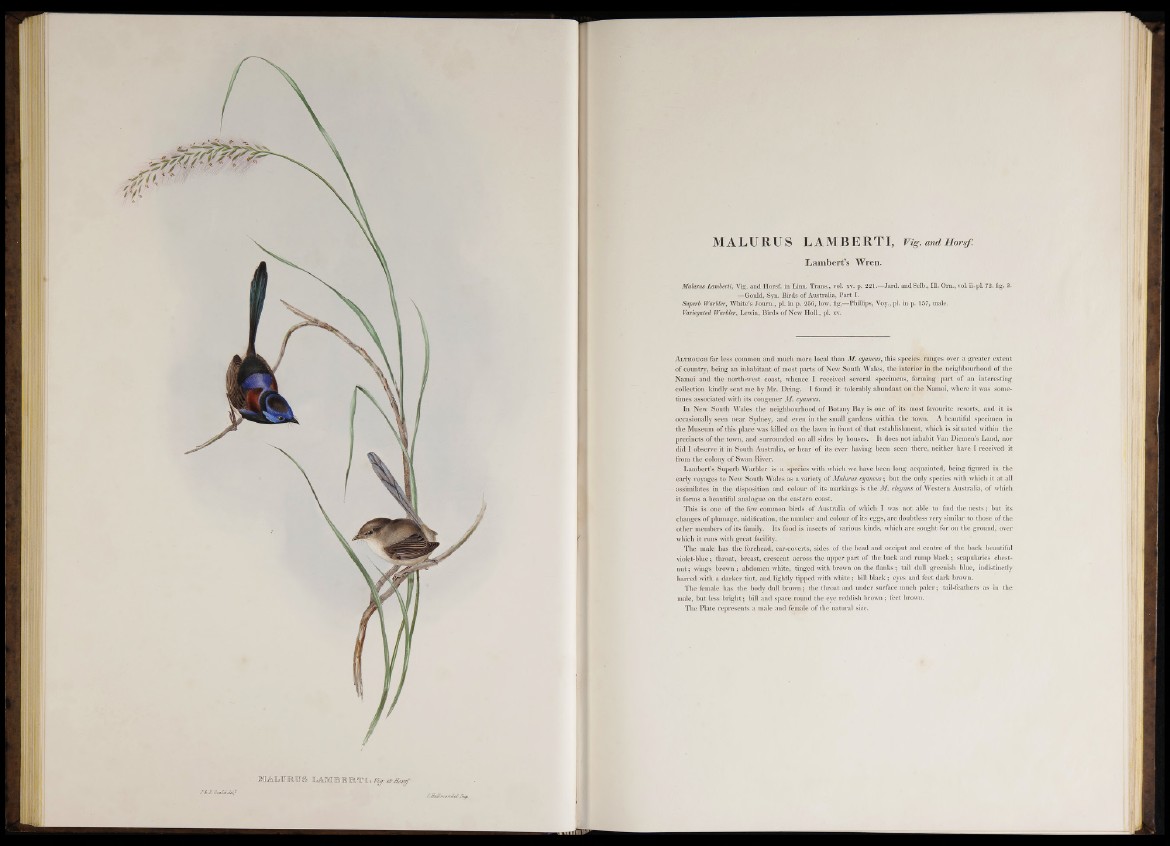
w m m ,
9BHH
W m im S r . l $ P /l
MALURUS LAMBERTI, n g. and H o rsf .
Lambert’s Wren.
Mahrus Lamberti, Vig. and Horsf. in Linn. Trans., vol. xv. p. 221.—Jard. andSelb., 111. Om., vol. ii. pi. 72. fig. 2.
—Gould, Syn. Birds of Australia, Part I.
Superb Warbler, White’s Joum., pi. in p. 256, low. fig.—Phillips, Voy., pi. in p. 157, male.
Variegated Warbler, Lewin, Birds of New Holl., pi. xv.
A lthough far less common and much more local than M. cyaneus, this species ranges over a greater extent
o f country, being an inhabitant o f most parts of New South Wales, the interior in the neighbourhood o f the
Namoi and the north-west coast, whence I received several specimens, forming part o f an interesting
collection kindly sent me by Mr. Dring. I found it tolerably abundant on the Namoi, where it was sometimes
associated with its congener M. cyaneus.
In New South Wales the neighbourhood of Botany Bay is one o f its most favourite resorts, and it is
occasionally seen near Sydney, and even in the small gardens within the town. A beautiful specimen in
the Museum of this place was killed on the lawn in front of that establishment, which is situated within the
precincts of the town, and surrounded on all sides by houses. It does not inhabit Van Diemen’s Land, nor
did I observe it in South Australia, or hear o f its ever having been seen there, neither have I received it
from the colony of Swan River.
Lambert’s Superb Warbler is a species with which we have been long acquainted, being figured in the
early voyages to New South Wales as a variety o f Malurus cyaneus; but the only species with which it at all
assimilates in the disposition and colour of its markings is the M. elegans of Western Australia, of which
it forms a beautiful analogue on the eastern coast.
This is one o f the few common birds of Australia o f which I was not able to find tbe nests; but its
changes of plumage, nidification, the number and colour o f its eggs, are doubtless very similar to those o f the
other members o f its family. Its food is insects o f various kinds, which are sought for on the ground, over
which it runs with great facility.
The male has the forehead, ear-coverts, sides of the head and occiput and centre of the back beautiful
violet-blue; throat, breast, crescent across the upper part of the back and rump black; scapularies chestnut
; wings brown ; abdomen white, tinged with brown on the flanks; tail dull greenish blue, indistinctly
barred with a darker tint, and lightly tipped with white; bill black; eyes and feet dark brown.
The female has the body dull brown; the throat and under surface much paler; tail-feathers as in the
male, but less bright; bill and space round the eye reddish brown; feet brown.
The Plate represents a male and female of tbe natural size.